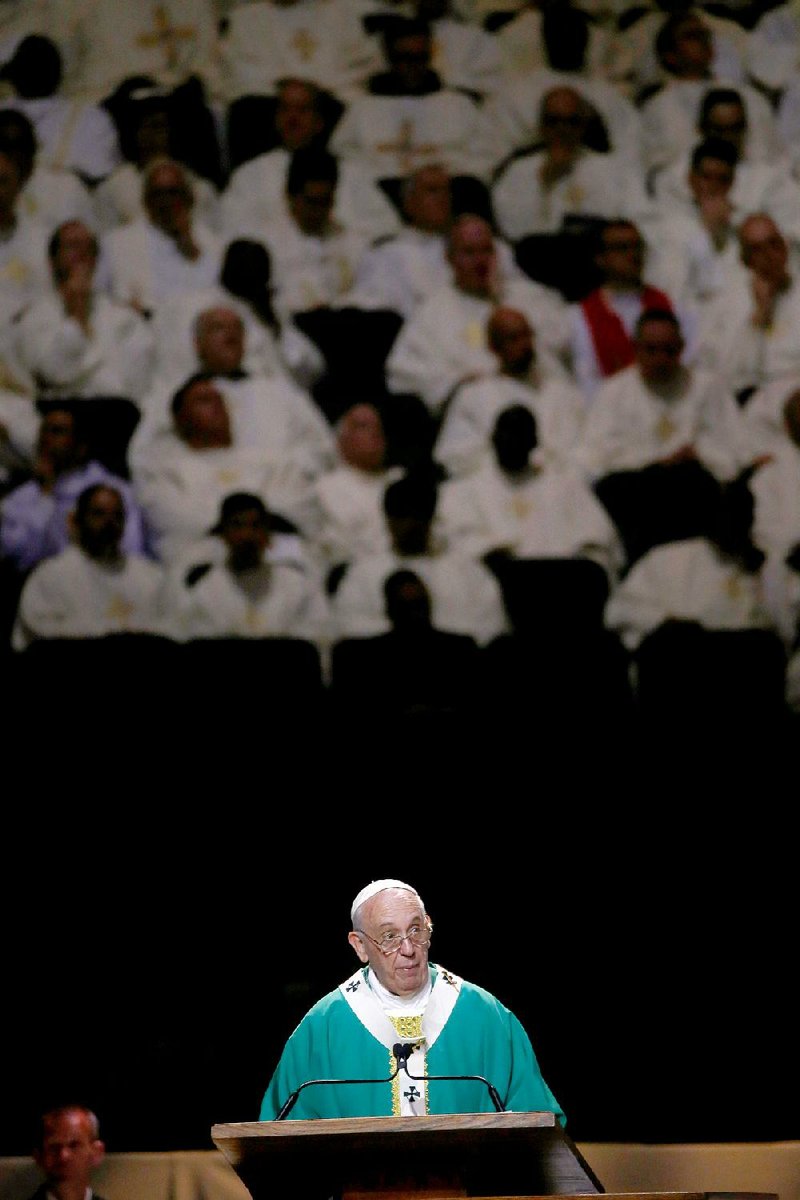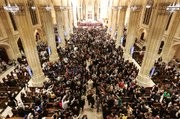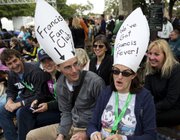NEW YORK -- At Our Lady of Refuge in the Bronx on a recent Sunday, a Christmas-size crowd of 800 people, as many as 200 more than normal, forced the priests to open the choir loft.
At Catholic Charities in New York, whose work with immigrants and refugees the pope highlighted during his trip, the director has received scores of messages from people eager to heed Pope Francis' call to help the poor and marginalized.
And at a Jesuit regional office in Maryland, where the Rev. Charles Frederico usually fields just a few calls a week from people on the East Coast interested in becoming priests, 20 inquiries have been made in recent days -- all since the pope, a Jesuit, landed in the United States last month.
"He just seems to radiate this sense of freedom, this sense of openness, this sense of hospitality that is infectious," said Shaun Slusarski, 26, a Jesuit high school teacher in Philadelphia who had been contemplating joining the religious order but said Francis' visit had clinched his decision. "It makes you want to live that way."
Over six days, throngs of Roman Catholics and non-Catholics in three cities swooned over Francis, the "People's Pope," who asked the downtrodden and the mighty alike to pray for him. The crowds have gone home. But a papal afterglow remains, injecting the American church with new energy in small but unmistakable ways.
For the dioceses of the Northeast, where parishes have struggled for years with dwindling numbers -- of parishioners, priests and resources -- Francis' feverishly followed American tour represents a precious opportunity. Many of the Catholic faithful are invigorated. The right nudge could bring them back to the church every Sunday, their children back to its schools and even their dollars back to its coffers.
While it could easily be short-lived, Catholic officials at every level, from parish priests to archdiocesan officials, are now praying -- and strategizing -- over how to sustain a Francis bounce.
At the Archdiocese of New York, Cardinal Timothy M. Dolan, who is the archbishop, opened a staff meeting the day after the pope left the United States with a question: Now what?
The topic was simple: "How do we build on this? How do we take this moment of evangelization that we just experienced and build on it and really reach out to people?" said Joseph Zwilling, the archdiocese's communications director. "The worst thing that could happen would be for somebody to be moved by Pope Francis' visit, and then to come to the parish and feel like they've been turned away, that they don't feel that warmth."
The archdiocese's Inner-City Scholarship Fund, a charity that helps poor children pay for Catholic schools, wasted no time, taking out a full-page ad in The New York Post appealing for donations. The ad featured a photo of Francis greeting students at Our Lady Queen of Angels school in East Harlem, where he met schoolchildren, as well as immigrants and refugees served by Catholic Charities.
Church charities and other groups that received a boost from Francis' visit were hoping the attention would encourage donations.
"For us," said Cecilia Greene, a spokesman for the Partnership for Inner-City Education, the charter-style network that manages Our Lady Queen of Angels, "doors that were mildly ajar are becoming more open to us as a result."
Catholic Charities of the Archdiocese of New York plans to urge parishioners to get involved in initiatives like food pantries and welcoming and integrating immigrants.
"Pope Francis' message was that religion needs to go beyond the house of worship, that religious people need to be involved in the world," said Monsignor Kevin Sullivan, the group's executive director. "We're going to try to give people the opportunities to show that in their lives."
In the Brooklyn Diocese, Francis' emphasis on ministering to the needy has spurred a group of volunteers to start planning a regular distribution of sandwiches to the hungry, said Monsignor Kieran Harrington, a spokesman for the diocese.
"The fruits will be seen later," Harrington said. "The seeds have just been scattered."
It is too early to gauge any lasting effects from Francis' visit, much less the results of Catholic officials' efforts to capitalize on it. But there is at least some anecdotal evidence that previous papal visits have had a measurable impact on parts of the church.
Pope Benedict XVI's visit to New York in 2008 led to a jump in ordinations that is only now being felt, said Zwilling, the archdiocese's communications director. A dozen new priests for the archdiocese are graduating from St. Joseph's Seminary in Yonkers this year, about double the recent average.
For the Jesuits, noted for their intellectual questioning and emphasis on social justice, the papal visit has brought a surge of interest.
"Francis has enabled people to talk about the option again, in a way I haven't experienced in my seven years on the job," said Frederico, the Jesuits' director of vocations for the territory that covers Maine to Georgia.
The 20 calls to Frederico's office do not necessarily mean 20 new Jesuit priests. The Jesuits' rigorous training takes 10 years, and Jesuits must take a lifelong vow of poverty, in addition to the usual celibacy.
It also remains to be seen whether those people who returned to Mass after the pope's visit after years away, or who found themselves peeking inside a church for the first time ever, will keep coming back.
Reports of fuller-than-usual churches have arrived from Albany, N.Y., from Pennsylvania and from Massachusetts. At Our Lady of Refuge in the Bronx, the crowd of approximately 800 people who packed the pews at the 11:30 a.m. Spanish-language Mass on a recent Sunday was the kind that would normally show up only around the holidays, said Bishop John Jenik, the pastor.
At St. Mary Star of the Sea in Brooklyn, 20 new faces appeared on the morning of Sept. 27 -- a significant gain for a Mass that usually attracts 150 to 200 people, said the Rev. Chris Cashman, the pastor. Seemingly everyone wanted to stop and talk about Francis: how they had snapped photos of him in Central Park; how he had looked straight at them; how excited they were to have seen him.
"He has a gift, this pope," Cashman said. "Even the people that are already in the church, the lifelong people, this has energized them. It's just something about the man -- it just renews your faith in faith."
Religion on 10/10/2015


